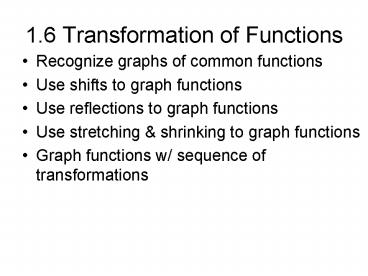1'6 Transformation of Functions - PowerPoint PPT Presentation
1 / 27
Title:
1'6 Transformation of Functions
Description:
The following basic graphs will be used extensively in this section. ... We will now see how certain transformations (operations) of a function change its graph. ... – PowerPoint PPT presentation
Number of Views:36
Avg rating:3.0/5.0
Title: 1'6 Transformation of Functions
1
1.6 Transformation of Functions
- Recognize graphs of common functions
- Use shifts to graph functions
- Use reflections to graph functions
- Use stretching shrinking to graph functions
- Graph functions w/ sequence of transformations
2
The following basic graphs will be used
extensively in this section. It is important to
be able to sketch these from memory.
3
The identity function f(x) x
4
The squaring function
5
The square root function
6
The absolute value function
7
The cubing function
8
The cube root function
9
We will now see how certain transformations
(operations) of a function change its graph. This
will give us a better idea of how to quickly
sketch the graph of certain functions. The
transformations are (1) translations, (2)
reflections, and (3) stretching.
10
Vertical Translation
- Vertical Translation
- For b gt 0,
- the graph of y f(x) b is the graph of y
f(x) shifted up b units - the graph of y f(x) ? b is the graph of y
f(x) shifted down b units.
11
Horizontal Translation
- Horizontal Translation
- For d gt 0,
- the graph of y f(x ? d) is the graph of y
f(x) shifted right d units - the graph of y f(x d) is the graph of y
f(x) shifted left d units.
12
- Vertical shifts
- Moves the graph up or down
- Impacts only the y values of the function
- No changes are made to the x values
- Horizontal shifts
- Moves the graph left or right
- Impacts only the x values of the function
- No changes are made to the y values
13
The values that translate the graph of a function
will occur as a number added or subtracted either
inside or outside a function.Numbers added or
subtracted inside translate left or right, while
numbers added or subtracted outside translate up
or down.
14
Recognizing the shift from the equation, examples
of shifting the function f(x)
- Vertical shift of 3 units up
- Horizontal shift of 3 units left (HINT xs go
the opposite direction that you might believe.)
15
Points represented by (x , y) on the graph of
f(x) become
If the point (6, -3) is on the graph of
f(x), find the corresponding point on the graph
of f(x3) 2
16
Use the basic graph to sketch the following
17
Combining a vertical horizontal shift
- Example of function that is shifted down 4 units
and right 6 units from the original function.
18
Reflections
- The graph of ?f(x) is the reflection of the
graph of f(x) across the x-axis. - The graph of f(?x) is the reflection of the
graph of f(x) across the y-axis. - If a point (x, y) is on the graph of f(x), then
- (x, ?y) is on the graph of ?f(x), and
- (?x, y) is on the graph of f(?x).
19
Reflecting
- Across x-axis (y becomes negative, -f(x))
- Across y-axis (x becomes negative, f(-x))
20
Use the basic graph to sketch the following
21
Vertical Stretching and Shrinking
- The graph of af(x) can be obtained from the
graph of f(x) by - stretching vertically for a gt 1, or
- shrinking vertically for 0 lt a lt 1.
- For a lt 0, the graph is also reflected across the
x-axis. - (The y-coordinates of the graph of y af(x) can
be obtained by multiplying the y-coordinates of y
f(x) by a.)
22
VERTICAL STRETCH (SHRINK)
- ys do what we think they should If you see
3(f(x)), all ys are MULTIPLIED by 3 (its now 3
times as high or low!)
23
Horizontal Stretching or Shrinking
- The graph of y f(cx) can be obtained from the
graph of y f(x) by - shrinking horizontally for c gt 1, or
- stretching horizontally for 0 lt c lt 1.
- For c lt 0, the graph is also reflected across the
y-axis. - (The x-coordinates of the graph of y f(cx) can
be obtained by dividing the x-coordinates of the
graph of y f(x) by c.)
24
Horizontal stretch shrink
- Were MULTIPLYING by an integer (not 1 or 0).
- xs do the opposite of what we think they should.
(If you see 3x in the equation where it used to
be an x, you DIVIDE all xs by 3, thus its
compressed horizontally.)
25
Sequence of transformations
- Follow order of operations.
- Select two points (or more) from the original
function and move that point one step at a time. - f(x) contains (-1,-1), (0,0), (1,1)
- 1st transformation would be (x2), which moves
the function left 2 units (subtract 2 from each
x), - pts. are now (-3,-1), (-2,0), (-1,1)
- 2nd transformation would be 3 times all the ys,
- pts. are now (-3,-3), (-2,0), (-1,3)
- 3rd transformation would be subtract 1 from all
ys, pts. are now (-3,-4), (-2,-1), (-1,2)
26
Graph of Example
(-1,-1), (0,0), (1,1)
(-3,-4), (-2,-1), (-1,2)
27
The point (-12, 4) is on the graph of y f(x).
Find a point on the graph of y g(x).
- g(x) f(x-2)
- g(x) 4f(x)
- g(x) f(½x)
- g(x) -f(x)
- (-10, 4)
- (-12, 16)
- (-24, 4)
- (-12, -4)































